The Shui people (水族) are one of the ethnic minority groups who live mainly in the Sandu Shui Autonomous County (三都水族自治县) of southwest China’s Guizhou Province (贵州省).
The Shui (Sui) are descendants of the ancient Baiyue (百越) who lived in the area of southern China and northern Vietnam beginning in the first millennium BC.
“Shui” (水) actually means “water”. The Shui people tend to live near rivers and streams and much of their customs and folklore revolves around water.
They are primarily engaged in rice farming but fish also play an important role in their diet and lives.

The ancient ‘Shui Shu” pictographic script resembles the symbols used on oracle bones
While they now use Chinese as their written language, they have a rich cultural heritage that includes an ancient written language known as “Shui Shu” (水书) or “Shui Scripts”.
Examples of Shui Shu characters are shown at the left.
Shui Shu uses pictographs which are similar to the characters (jiaguwen 甲骨文) found on the ancient oracle bones from the Shang Dynasty and the characters (jinwen 金文) on ancient ritual bronzes from the Shang and Zhou dynasties.
There are even scholars who believe that Shui Shu preceded jiaguwen and is, in fact, “the source of the Chinese language”.
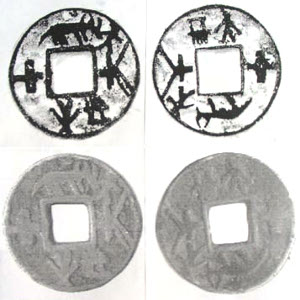
The only Shui Nationality coin known to exist
The picture at the left shows the only coin from the Shui Nationality known to exist.
The coin was discovered in 2004.
The obverse and reverse sides of the coin, which are almost identical, are shown at the bottom with rubbings at the top.
According to Mr. Pan Chaolin (潘朝霖), who is a researcher at the Guizhou University for Nationalities (贵州民族学院), the inscription written in Chinese characters at the left and right of the square hole reads da zhong (大中).
“Da zhong” refers to one of the reign titles of Emperor Zhen Zong (998-1022 AD) of the Northern Song Dynasty. The dazhong xiangfu (大中祥符) era was the period 1008-1016 AD.
What is particularly interesting, however, are the other symbols on the coin.
Above the square hole in the rubbing on the left, a man can be seen with his arm extended backwards leading an ox.
In the rubbing on the right, a man can be seen above the square hole pulling a “rake” (ba 耙) which is an ancient type of plough.
In Shui Shu, according to Mr. Pan, a symbol resembling the head of the water ox represents wealth.
Similarly, the symbol of the “rake” (耙) also represents wealth because it was an important agricultural tool.
Therefore, using the ox and plough on the coin clearly symbolize wealth according to Mr. Pan.
The coins of the Shui are clearly distinctive from those of the Han Chinese and this is the case for their charms as well.
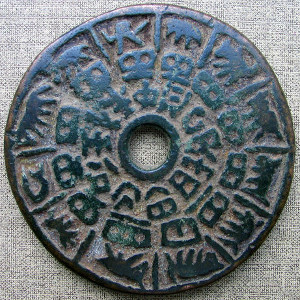
This rare charm displays the 12 animals of the Chinese Zodiac with the 12 Earthly Branches written in Shui Script
The image at the left displays a rare charm from the Shui Nationality.
The theme is not unusual and is frequently seen on Chinese charms. The obverse side displays two dragons and the reverse shows the 12 animals of the Chinese zodiac.
However, this particular Shui version of the charm is the only specimen known to exist.
As seen here, the 12 animals of the Chinese zodiac are shown near the outer rim.
While Chinese versions of the charm have the names of the Twelve Earthly Branches (十二地支) written in Chinese characters around the center hole, you will notice that the names on this charm are written in Shui Shu.
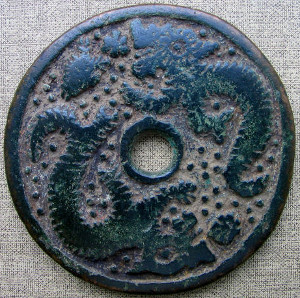
The obverse side of the Shui charm shows a male dragon and a female dragon
The obverse side of the charm displays two dragons.
The story being told is of a fish transforming into a dragon.
As already mentioned, the fish is an important part of the lives and cultural heritage of the Shui.
Like the ox and rake, fish represent prosperity and also symbolize the ancestors of the Shui people.
(In Chinese myth, a carp leaping over the Dragon Gate becomes a dragon.)
If you look carefully, you will see a fish near the outer rim at about the 10 o’clock position.
At the 5 o’clock position near the rim can be seen a pearl.
The two dragon design is frequently seen on old Chinese charms. However, there is a major difference in the way the dragons on this charm are illustrated in comparison with those found on Chinese charms.
Unlike Chinese charms, there is clearly one male and one female dragon on this Shui charm.
The dragon at the upper right is the female.
The dragon which is upside down at the lower left is the male. The tail of the male dragon makes a curve towards the outside rim at about the 9 o’clock position. Just before the tail hooks towards the outside rim, you will observe that there is an appendage that extends towards the inner hole.
This “appendage” is the male genitals (生殖器).
The female dragon, of course, lacks this feature.
Incidentally, this type of dragon is colloquially known as a “cock dragon” (鸡巴龙) because the shape of the head is similar to that of a chicken.
Curiously enough, this depiction of the male dragon is not unique to the Shui but is also found on charms from other ethnic minority groups from the same geographic area.
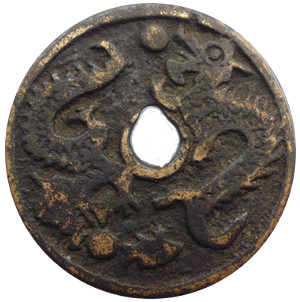
An old ‘double dragon’ charm from the Qiannan area of Guizhou Province
At the left is an almost identical charm from the Qiannan area of Guizhou (贵州黔南).
In this view, the male dragon is on the right and the female is upside down on the left. The pearl is at the top of the charm and the fish is at the bottom.
As is the case with the Shui charm, the genitals of the male dragon can be seen just below the round hole.
Depicting both male and female dragons is an important difference between the Shui and Chinese charms.
However, another major difference has to do with the area surrounding the dragons.
On the Shui charm this background area is filled with small protruding “dots”.
This characteristic is similar to the design found on ancient Chinese bronzes. Archaeologists refer to these “dots” as “nipples” (乳丁) because of the similarity to the nipple of the female breast.
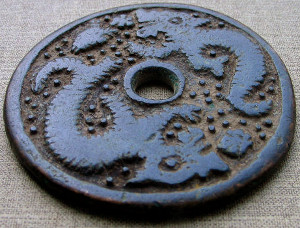
The “stars” in the heavens are in high relief
When the charm is viewed at an angle, as shown at the left, it can be clearly seen that the “nipples” are in high relief.
(The difference between the male and female dragons is also more obvious in this view.)
These dots represent the stars in the heavens.
While dots representing stars are sometimes seen on old Chinese coins and charms, it is rare to see the entire field filled with them as is the case with this Shui charm.
Even the charm from the neighboring Qiannan area does not have this star background.
Such an immense star-studded field is appropriate for the theme of this charm.
Once a fish transforms itself into a dragon, it has the ability to “mount the clouds and ride the mists” (腾云驾雾) and “call for the wind and rain” (呼风唤雨).
The dragon reigns supreme among all the spirits. But because the transformation begins with the fish, the fish is also considered to be a spirit.
Even today there are areas of China where the local people are afraid of provoking fish, and would never fry one in a wok, because they consider fish to be spirits.
This coin and charm are rare treasures that provide insight into the very ancient cultural heritage of the Shui people.